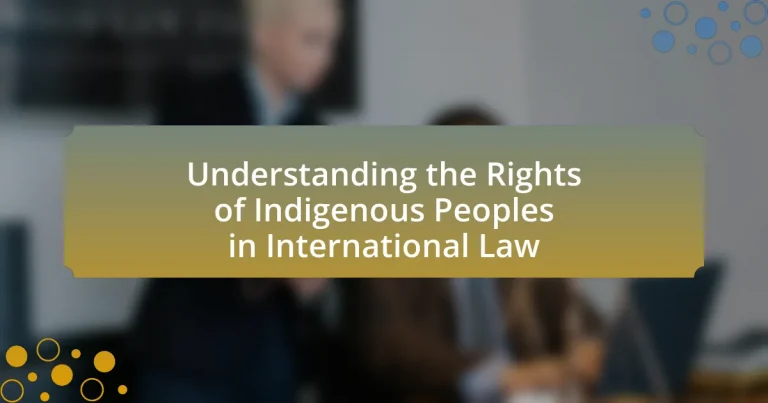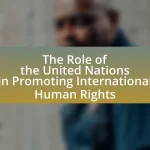The article focuses on the rights of Indigenous peoples in international law, highlighting their entitlements to self-determination, cultural preservation, land management, and participation in decision-making processes. It examines key international instruments such as the United Nations Declaration on the Rights of Indigenous Peoples (UNDRIP) and the International Labour Organization’s Convention No. 169, which provide frameworks for recognizing and protecting these rights. The article also discusses the criteria for defining Indigenous peoples, the historical injustices that have led to the acknowledgment of their rights, and the challenges faced in enforcing these rights globally. Additionally, it outlines the mechanisms available for Indigenous peoples to seek justice and the role of non-governmental organizations in advocacy efforts.
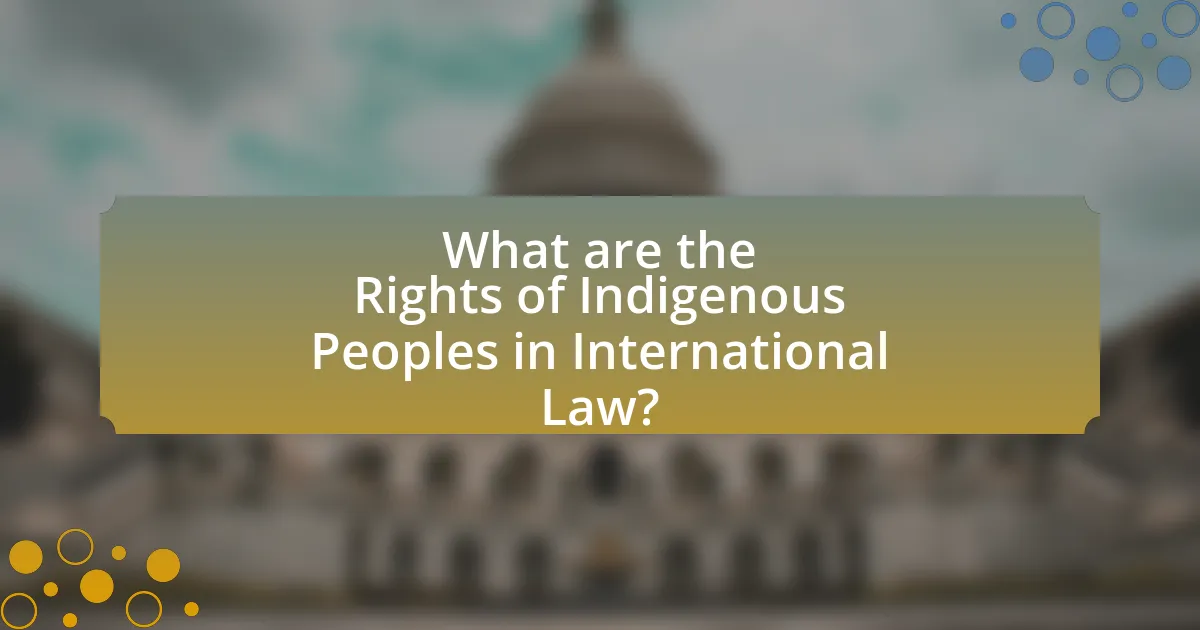
What are the Rights of Indigenous Peoples in International Law?
The rights of Indigenous peoples in international law include the right to self-determination, cultural preservation, land and resource management, and participation in decision-making processes that affect their lives. These rights are recognized in various international instruments, such as the United Nations Declaration on the Rights of Indigenous Peoples (UNDRIP), adopted in 2007, which emphasizes the importance of respecting Indigenous cultures, languages, and traditions. Additionally, the International Labour Organization’s Convention No. 169 provides specific protections for Indigenous peoples, including their rights to land and resources. These legal frameworks establish a foundation for the recognition and protection of Indigenous rights globally, affirming their status as distinct peoples with unique identities and rights.
How are Indigenous Peoples defined in international legal contexts?
Indigenous Peoples are defined in international legal contexts as distinct social and cultural groups that have historical ties to specific territories and maintain their own social, economic, and political institutions. This definition is supported by the United Nations Declaration on the Rights of Indigenous Peoples, which recognizes their rights to self-determination, cultural preservation, and land. Additionally, the International Labour Organization’s Convention No. 169 emphasizes the importance of respecting the identities and traditions of Indigenous Peoples, further solidifying their status in international law.
What criteria are used to identify Indigenous Peoples?
Indigenous Peoples are identified based on specific criteria that include self-identification, historical continuity, cultural distinctiveness, and connection to ancestral territories. Self-identification refers to the recognition by individuals as part of a distinct group, while historical continuity emphasizes the group’s long-standing presence in a particular region prior to colonization. Cultural distinctiveness involves unique languages, traditions, and social practices that differentiate them from the dominant society. Connection to ancestral territories highlights the relationship between Indigenous Peoples and their traditional lands, which is often integral to their identity and way of life. These criteria are recognized in various international frameworks, such as the United Nations Declaration on the Rights of Indigenous Peoples, which underscores the importance of these elements in defining Indigenous identity.
How does the definition vary across different legal frameworks?
The definition of Indigenous peoples varies across different legal frameworks, reflecting diverse cultural, historical, and political contexts. For instance, the United Nations defines Indigenous peoples based on self-identification and distinct social, cultural, and economic practices, while the International Labour Organization (ILO) emphasizes the historical continuity and connection to ancestral territories. National legal frameworks, such as those in Canada and Australia, may adopt specific criteria that include language, cultural practices, and community recognition, leading to variations in rights and protections afforded to Indigenous groups. These differences illustrate how legal definitions are shaped by the specific objectives and values of each framework, impacting the recognition and enforcement of Indigenous rights globally.
Why are the rights of Indigenous Peoples important in international law?
The rights of Indigenous Peoples are important in international law because they recognize and protect the unique cultural, social, and economic identities of these communities. International legal frameworks, such as the United Nations Declaration on the Rights of Indigenous Peoples (UNDRIP), affirm Indigenous rights to self-determination, land, and resources, which are essential for their survival and development. These rights are crucial for addressing historical injustices, promoting social equity, and ensuring that Indigenous voices are included in decision-making processes that affect their lives and territories.
What historical injustices have led to the recognition of these rights?
Historical injustices such as colonization, forced assimilation, and systemic discrimination have led to the recognition of the rights of Indigenous peoples. Colonization resulted in the dispossession of Indigenous lands, cultures, and identities, exemplified by events like the Doctrine of Discovery, which justified European claims to Indigenous territories. Forced assimilation policies, including residential schools in Canada and the United States, aimed to eradicate Indigenous cultures and languages, causing lasting trauma and loss of identity. Systemic discrimination, reflected in legal frameworks that marginalized Indigenous voices and rights, has prompted international responses, such as the United Nations Declaration on the Rights of Indigenous Peoples in 2007, which acknowledges these historical injustices and seeks to rectify them by affirming Indigenous rights to self-determination, land, and cultural preservation.
How do these rights contribute to global human rights standards?
Indigenous rights contribute to global human rights standards by establishing frameworks that recognize the unique cultural, social, and economic needs of Indigenous populations. These rights, enshrined in instruments like the United Nations Declaration on the Rights of Indigenous Peoples (UNDRIP), promote self-determination, land rights, and cultural preservation, thereby influencing international norms and policies. For instance, the adoption of UNDRIP in 2007 marked a significant advancement in acknowledging Indigenous peoples’ rights, leading to increased global awareness and legal recognition of their status. This shift has encouraged countries to align their national laws with international human rights standards, fostering a more inclusive approach to human rights that respects the diversity of cultures and identities worldwide.
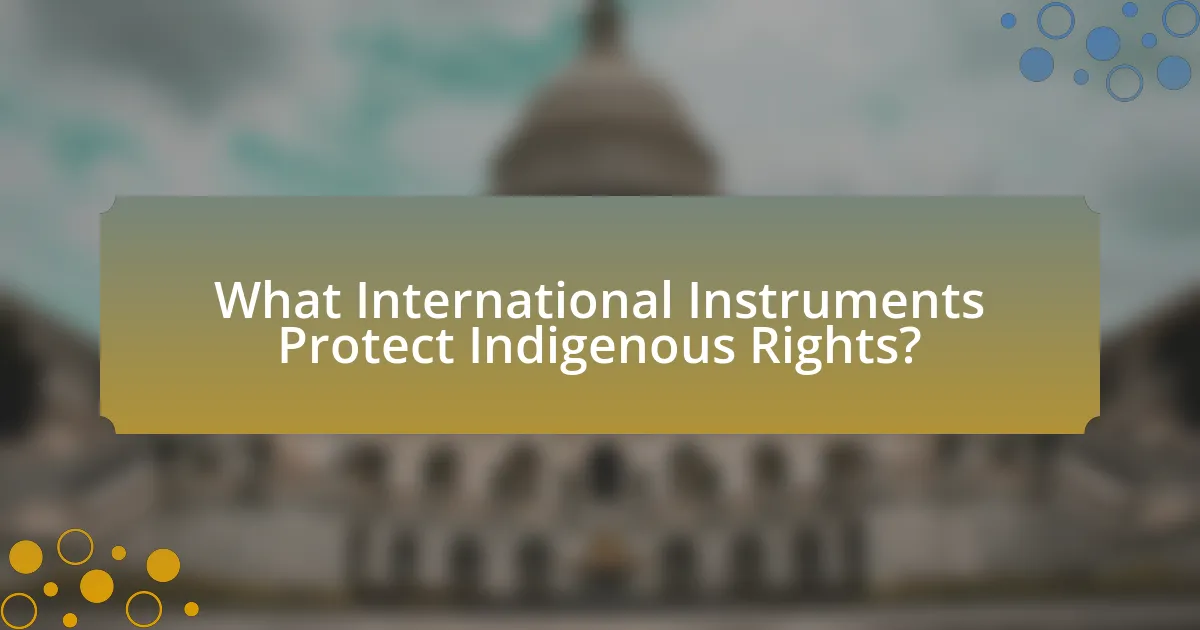
What International Instruments Protect Indigenous Rights?
International instruments that protect Indigenous rights include the United Nations Declaration on the Rights of Indigenous Peoples (UNDRIP), the International Labour Organization’s Convention No. 169, and the Convention on Biological Diversity. UNDRIP, adopted in 2007, outlines the individual and collective rights of Indigenous peoples, emphasizing their rights to self-determination, cultural preservation, and land. ILO Convention No. 169, ratified by various countries, focuses on the rights of Indigenous and tribal peoples in relation to employment, land, and cultural identity. The Convention on Biological Diversity recognizes the role of Indigenous knowledge in biodiversity conservation and sustainable use. These instruments collectively establish a framework for the protection and promotion of Indigenous rights at the international level.
What is the role of the United Nations Declaration on the Rights of Indigenous Peoples?
The United Nations Declaration on the Rights of Indigenous Peoples serves to affirm and protect the rights of Indigenous peoples globally. This declaration establishes a framework for the recognition of their rights to self-determination, cultural preservation, and land ownership. Adopted by the UN General Assembly in 2007, it emphasizes the importance of Indigenous peoples’ participation in decision-making processes that affect their lives and communities. The declaration also addresses issues such as discrimination, cultural rights, and the need for effective remedies for violations of Indigenous rights, thereby providing a crucial legal and moral foundation for advocating for Indigenous rights within international law.
What key provisions does the Declaration include?
The Declaration on the Rights of Indigenous Peoples includes key provisions that affirm the rights of Indigenous peoples to self-determination, cultural preservation, and land ownership. Specifically, it recognizes their right to maintain and strengthen their distinct political, legal, economic, social, and cultural institutions, as well as their right to participate in decision-making processes that affect them. Additionally, the Declaration emphasizes the importance of protecting Indigenous languages, traditions, and customs, and it mandates states to consult Indigenous peoples in matters that impact their rights and territories. These provisions are grounded in international human rights standards, reflecting a commitment to rectify historical injustices faced by Indigenous communities.
How has the Declaration influenced national laws?
The Declaration has significantly influenced national laws by providing a framework for the recognition and protection of the rights of Indigenous peoples. Many countries have incorporated principles from the Declaration into their legal systems, leading to the establishment of laws that affirm Indigenous land rights, cultural preservation, and self-determination. For example, countries like Canada and New Zealand have enacted legislation that aligns with the Declaration, such as the Canadian Constitution Act of 1982, which recognizes the rights of Indigenous peoples, and New Zealand’s Treaty of Waitangi, which acknowledges Māori rights. These legal adaptations demonstrate the Declaration’s role in shaping national policies and promoting the rights of Indigenous communities globally.
What other international treaties and conventions support Indigenous rights?
Several international treaties and conventions support Indigenous rights, including the United Nations Declaration on the Rights of Indigenous Peoples (UNDRIP), the International Labour Organization’s Convention No. 169, and the Convention on Biological Diversity. UNDRIP, adopted in 2007, establishes a universal framework of minimum standards for the survival, dignity, and well-being of Indigenous peoples. ILO Convention No. 169, ratified by various countries, focuses on the rights of Indigenous and tribal peoples in relation to land, resources, and cultural preservation. The Convention on Biological Diversity, which emphasizes the importance of traditional knowledge and practices of Indigenous peoples in biodiversity conservation, further reinforces their rights. These instruments collectively affirm and protect the rights of Indigenous peoples on a global scale.
How do these treaties address specific rights of Indigenous Peoples?
Treaties addressing the rights of Indigenous Peoples specifically recognize their rights to land, culture, self-determination, and participation in decision-making processes. For instance, the United Nations Declaration on the Rights of Indigenous Peoples (UNDRIP) explicitly affirms the right of Indigenous Peoples to maintain and strengthen their distinct political, legal, economic, social, and cultural institutions, as well as their right to own, use, develop, and control their traditional lands and resources. This is supported by Article 26 of UNDRIP, which states that Indigenous Peoples have the right to the lands, territories, and resources they have traditionally owned or otherwise occupied or used. Additionally, the International Labour Organization’s Convention No. 169 emphasizes the need for consultation with Indigenous Peoples regarding projects affecting their lands and resources, thereby ensuring their participation in governance. These treaties collectively establish a framework that protects and promotes the specific rights of Indigenous Peoples in international law.
What challenges exist in the implementation of these treaties?
The challenges in the implementation of treaties concerning the rights of Indigenous peoples include lack of political will, insufficient resources, and inadequate legal frameworks. Political will is often weak among governments, leading to delays or failures in enacting necessary legislation. For instance, many countries have signed treaties but have not ratified them or have not integrated their provisions into domestic law. Insufficient resources hinder the ability of Indigenous communities to engage in treaty processes effectively, as they may lack funding for legal representation or advocacy. Additionally, legal frameworks may not adequately recognize Indigenous rights, creating barriers to enforcement and compliance. These challenges collectively impede the realization of the rights outlined in international treaties, such as the United Nations Declaration on the Rights of Indigenous Peoples, which aims to protect and promote these rights globally.
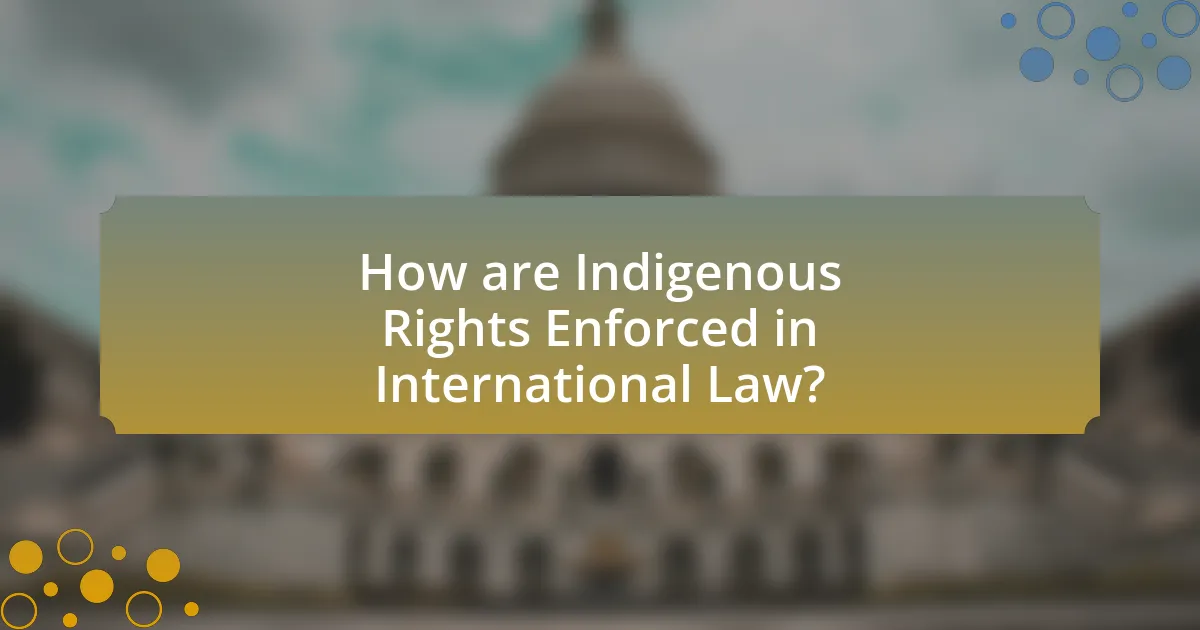
How are Indigenous Rights Enforced in International Law?
Indigenous rights are enforced in international law primarily through various treaties, declarations, and legal frameworks established by international organizations. The United Nations Declaration on the Rights of Indigenous Peoples (UNDRIP), adopted in 2007, serves as a key instrument, outlining the rights of Indigenous peoples and emphasizing their right to self-determination, cultural preservation, and land rights. Additionally, the International Labour Organization’s Convention No. 169 specifically addresses the rights of Indigenous and tribal peoples, requiring states to consult with Indigenous communities regarding projects affecting their lands and resources. Enforcement mechanisms include monitoring by international bodies, reporting obligations for states, and the potential for Indigenous groups to bring complaints to international human rights mechanisms, such as the UN Human Rights Council. These frameworks collectively aim to protect Indigenous rights and hold states accountable for violations.
What mechanisms exist for Indigenous Peoples to seek justice?
Indigenous Peoples can seek justice through various mechanisms, including international human rights treaties, national legal systems, and specialized bodies like the United Nations Permanent Forum on Indigenous Issues. International treaties such as the United Nations Declaration on the Rights of Indigenous Peoples (UNDRIP) provide a framework for Indigenous rights and avenues for grievance redress. National legal systems may offer Indigenous Peoples the ability to pursue claims through courts or alternative dispute resolution mechanisms. Additionally, regional human rights systems, such as the Inter-American Commission on Human Rights, allow Indigenous groups to bring cases related to land rights, cultural preservation, and discrimination. These mechanisms collectively empower Indigenous Peoples to advocate for their rights and seek justice effectively.
How do international courts and tribunals handle cases involving Indigenous rights?
International courts and tribunals handle cases involving Indigenous rights by interpreting and applying international human rights law, particularly through instruments such as the United Nations Declaration on the Rights of Indigenous Peoples (UNDRIP). These bodies assess claims related to land rights, cultural preservation, and self-determination, often relying on precedents set by previous rulings and the principles established in international treaties. For instance, the Inter-American Court of Human Rights has ruled in favor of Indigenous communities, emphasizing their rights to land and resources, as seen in the case of the Saramaka People v. Suriname, where the court recognized the necessity of Indigenous land rights for cultural survival.
What role do non-governmental organizations play in advocacy and enforcement?
Non-governmental organizations (NGOs) play a crucial role in advocacy and enforcement by promoting the rights of indigenous peoples and holding governments accountable. NGOs engage in activities such as raising awareness, conducting research, and providing legal assistance to ensure that indigenous rights are recognized and upheld in international law. For instance, organizations like Amnesty International and Human Rights Watch have documented violations of indigenous rights and lobbied for policy changes, influencing international treaties and national legislation. Their efforts contribute to the enforcement of existing laws and the establishment of new protections for indigenous communities, thereby reinforcing the framework of international human rights.
What are the challenges in enforcing Indigenous rights internationally?
Enforcing Indigenous rights internationally faces significant challenges, primarily due to the lack of binding legal frameworks and inconsistent implementation of existing agreements. Many countries have ratified international instruments like the United Nations Declaration on the Rights of Indigenous Peoples (UNDRIP), yet compliance varies widely, often influenced by national interests and political will. Additionally, Indigenous communities frequently encounter barriers such as limited access to legal resources, insufficient recognition of their land rights, and systemic discrimination, which hinder their ability to advocate for their rights effectively. These challenges are compounded by the complexities of international law, where sovereignty issues and the prioritization of state rights over Indigenous rights can lead to inadequate protections and enforcement mechanisms.
How do political and economic factors impact enforcement efforts?
Political and economic factors significantly impact enforcement efforts by shaping the priorities and resources allocated to law enforcement agencies. For instance, political will often determines the extent to which laws protecting indigenous rights are enforced, as seen in countries where governments prioritize economic development over indigenous land rights, leading to inadequate enforcement of existing protections. Economic factors, such as funding availability, also influence enforcement capabilities; jurisdictions with limited budgets may struggle to implement and uphold laws effectively. A study by the United Nations Permanent Forum on Indigenous Issues highlights that in regions where economic interests conflict with indigenous rights, enforcement of protections is often weak, demonstrating the direct correlation between these factors and the effectiveness of enforcement efforts.
What strategies can Indigenous Peoples use to overcome these challenges?
Indigenous Peoples can use legal advocacy, cultural revitalization, and community empowerment as strategies to overcome challenges related to their rights in international law. Legal advocacy involves utilizing international frameworks, such as the United Nations Declaration on the Rights of Indigenous Peoples, to assert their rights and seek redress for violations. Cultural revitalization focuses on preserving and promoting traditional practices, languages, and knowledge systems, which strengthens community identity and resilience. Community empowerment emphasizes building local governance structures and economic initiatives that enhance self-determination and reduce dependency on external systems. These strategies are supported by successful case studies, such as the recognition of land rights in Canada and the establishment of Indigenous-led organizations that have effectively negotiated with governments for better representation and resource management.
What practical steps can be taken to support Indigenous rights in international law?
Practical steps to support Indigenous rights in international law include the ratification and implementation of the United Nations Declaration on the Rights of Indigenous Peoples (UNDRIP) by states, which outlines the rights of Indigenous peoples to self-determination, land, and resources. Additionally, establishing legal frameworks that recognize and protect Indigenous land rights can enhance their autonomy and governance. Countries like Canada and New Zealand have made progress by incorporating Indigenous rights into their legal systems, demonstrating the effectiveness of such measures. Furthermore, promoting Indigenous participation in decision-making processes at local, national, and international levels ensures that their voices are heard and respected, aligning with international human rights standards.
